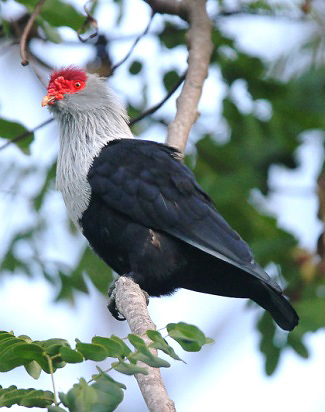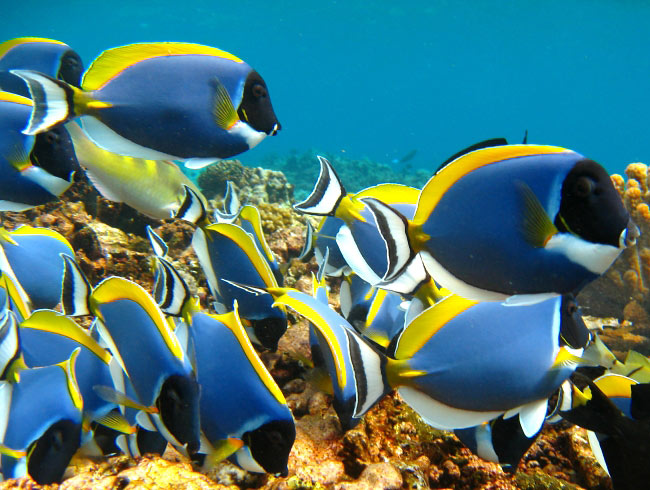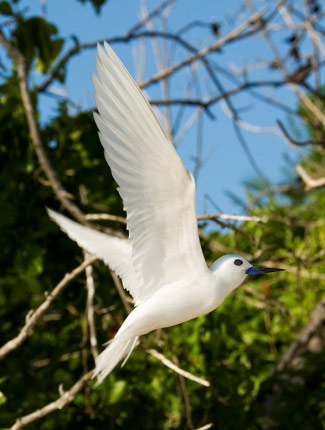

Seychelles Blue-pigeon on Mahe by Brian Field.
- Some of the rarest birds in the world including Seychelles Parrot, Seychelles Paradise-flycatcher, Seychelles Magpie-robin, Seychelles Fody and Seychelles White-eye, five of 12 bird species endemic to the islands
- And some spectacular seabird colonies with species such as Great and Lesser Frigatebirds, White-tailed Tropicbird, Sooty and White Terns, and Brown and Lesser Noddies
- As well as some shorebirds including Crab Plover
- On some of the most picturesque tropical islands in the world, complete with coconut
palm trees leaning over white sand beaches,
and coral reefs offshore
- For more information on the wildlife of the Seychelles and its conservation visit Nature Seychelles.
- Over 1000 km (700 miles) southwest of the Seychelles and actually much closer to the Comoros and Madagascar but administered by the Seychelles is the Aldabras, one of the largest coral atolls in the world, with four main islands; Aldabra, Assumption, Astove and Cosmoledo. The low-lying islands support four endemic birds; Aldabra Drongo, Aldabra White-eye, Abbott’s (Souimanga) Sunbird and Aldabra Fody, and two species shared only with Madagascar; White-throated Rail (the last remaining flightless bird in the Indian Ocean) and Madagascar Sacred Ibis, as well as spectacular seabird colonies with Brown, Masked and Red-footed Boobies, and Great and Lesser Frigatebirds, and other seabirds such as Red-tailed and White-tailed Tropicbirds, and Black-naped and White Terns, and in addition to the birds there are Coconut Crabs and over 100,000 Aldabra Giant Tortoises. Offshore the coral reefs are spectacular and apart from the colourful array of reef fishes there are Blacktip Reef and Lemon Sharks, and Green and Hawksbill Turtles.
Best Birds and other wildlife in the Seychelles
Birds
Endemics 12 Seychelles Blue-pigeon, Seychelles Swiftlet, Seychelles Scops-owl, Seychelles Kestrel, Seychelles Parrot (Praslin and Curieuse), Seychelles Paradise-flycatcher (mainly La Digue and Denis), Seychelles Warbler, Seychelles Bulbul, Seychelles White-eye (Mahe and Conception), Seychelles Magpie-robin, Seychelles Sunbird and Seychelles Fody.
Near-endemics
Seychelles and Madagascar 2 Souimanga Sunbird and Madagascar Cisticola.
Seychelles, Madagascar and Comoros 2 Madagascar Turtle-dove and Madagascar Bulbul.
Seychelles, Madagascar, Comoros and Mayotte 1 Madagascar White-eye.
Other specialities Crab Plover and White Tern.
Others Audubon’s and Wedge-tailed Shearwaters, Yellow Bittern, Black-crowned Night-heron, Striated Heron, Great and Lesser Frigatebirds, White-tailed Tropicbird, Brown and Lesser Noddies, and Bridled, Great Crested, Roseate and Sooty Terns. Also an outside chance of Red-footed Booby and Red-tailed Tropicbird. Introduced species include Zebra Dove, Common Myna and Madagascar Fody.
Mammals
Seychelles Fruit Bat.
Reptiles, Amphibians and Fish
Whale Shark (mostly September, and best looked for with the help of
The Marine Conservation Society Seychelles
who use spotter planes), coral reef fish, Green (mostly Apr-Sep) and Hawksbill (mostly Nov-Feb) Turtles, and Giant Tortoise (reintroduced).

Powder-blue Surgeonfish in the Seychelles by Marie-France Grenouillet.
Plants
Over 100 plant species are endemic including the Coco de Mer (a palm tree which bears a fruit with the largest
nuts of any plant in the world), the Seychelles Pitcher Plant and the Seychelles Vanilla Orchid.
Best Sites for Birds and other wildlife in the Seychelles
- Mahe The only island where the scops owl and white-eye may be seen, and which are only likely to be seen with a local guide, bookable through Seychelles Travel. Also the kestrel, the blue-pigeon and shorebirds including Crab Plover (at Brilliant Point Lagoon for example).
- Mahe-Praslin ferry crossing (one hour) A chance of Audubon's and Wedge-tailed Shearwaters, Sooty and White Terns, and Lesser Noddy.
- Praslin The only island where the parrot is likely to be seen. Also the kestrel and the blue-pigeon, and the famous Coco de Mer trees (in Vallee de Mai).
- Aride The warbler (translocated) and the magpie-robin (translocated), and about 750,000 pairs of nesting seabirds including Great and Lesser Frigatebirds, White-tailed Tropicbird, Roseate and Sooty Terns, and Lesser Noddy. Also an outside chance of Red-tailed Tropicbird (a few pairs) and the fody (translocated).
- Cousin The only island where the fody is likely to be seen. Also the warbler and the magpie-robin, nesting seabirds which include White-tailed Tropicbird, White Tern, Brown and Lesser Noddies, and Wedge-tailed Shearwater, and the most important nesting site for Hawksbill Turtles on Earth.
- La Digue The only island where the paradise-flycatcher may be seen (in Veuve Reserve; some birds have been translocated from La Digue to Denis Island (in 2008) and Curieuse Island (in 2019) to safeguard the species from extinction). Also the island with the iconic Anse Source d’Argent beach, complete with white sand and dark grey granite boulders, plus nesting White Terns.
- Bird At least a million nesting seabirds, mainly Sooty Terns but also including Great and Lesser Frigatebirds, White-tailed Tropicbird, White Tern, Brown and Lesser Noddies, and Wedge-tailed Shearwater, as well as nesting Green and Hawksbill Turtles. Also an outside chance of Red-footed Booby (roosting with frigatebirds).

White Tern on the Seychelles by Mike Hunter.
Best Times for Birds and other wildlife in the Seychelles
The best time for Whale Sharks is usually September and most seabirds nest from May to September during the southeast monsoon, which is breezier, cooler, drier and less humid than the northwest monsoon which usually lasts from November/December to February/March and can be particularly wet from December to February. So the optimum time to visit for most birds is October when it is normally less wet and windy.
Recommended Bird Books etc. for the Seychelles
Wildlife of Seychelles by J Bowler. PUP, 2006.
Birds of Seychelles by A Skerrett and T Disley. Helm, 2011 (Second Edition).
Birds of Madagascar and the Indian Ocean Islands by F Hawkins et al. Helm, 2015.
Birds of the Indian Ocean Islands by I Sinclair and O Langrand. Struik, 2013 (Revised Edition).
The Birds of Africa Volume 8: The Malagasy Region by R Safford and F Hawkins. Helm, 2013.
Underwater Guide to the Seychelles by C Mason-Parker and R Walton. John Beaufoy Publishing, 2015.
Reef and Freshwater Fish of Seychelles: A Field Guide by O, J and R Gerlach. Phelsuma Press, 2014 (Second Edition).
Birding and Wildlife Trip Reports for the Seychelles
Many trip reports, some for the Seychelles, are posted on the websites listed here. On some of these websites some reports are independent and some are posted by tour companies who organize tours to the Seychelles. These tour companies and others also post their own reports on their websites, which are listed under 'Some Organized Tours to the Seychelles' below.
- The best website for trip reports is CloudBirders
- but these are also worth a look
- Birdtours
- Fatbirder
- Jon Hornbuckle
- Mammal Watching
Local bird and wildlife guides in the Seychelles
The costs of organized tours partly reflect the quality of the tour leaders. Some leaders are certainly better than others and many companies claim their leaders are the best but even the best rely at least to some extent on the exceptional skills of the local guides they employ. If you are travelling independently, employing such local guides will greatly increase your chances of seeing the wildlife you wish to see.
Accommodation for birders in the Seychelles
Some Organized Tours for birds and other wildlife to the Seychelles
There are many tour companies who organize tours to see mammals, birds, other wildlife and other natural wonders. The cost of these tours vary considerably according to such variables as the airlines used, the number of days the tours last, the number of sites visited, the number of people in the group (an important consideration if you wish to see such wildlife as rainforest mammals and birds), the number of tour leaders, the standard of accommodation and transport, and the percentage profit the company hopes to make. Generally, where the number of days tours last and the number of sites visited are similar, the cheapest tours are those that use the cheapest airlines, accommodation and local transport, that have the largest groups with the least number of leaders, and that make the least amount of profit. The most expensive tours tend to be those which are exceptionally long, use the most expensive accommodation (ridiculously lavish in some cases, even for single nights) and which make the most profit. Some tour costs partly reflect the quality of the tour leaders. Some leaders are certainly better than others and many companies claim their leaders are the best but even the best rely at least to some extent on the exceptional skills of the local guides they employ.
While tour companies organize tours with set itineraries many also organize custom tours for individuals and private groups who instead of taking a tour with a set itinerary want to follow their own itinerary to suit their own personal tastes, whether it be mammals, birds, other wildlife, other natural wonders or even man-made attractions, or a mixture of them all. Many organized tours with set itineraries are also fast-paced and target as many species as possible, whether they are mammals, birds or other wildlife or everything, which usually leaves little time to enjoy the best sites and individual species, but on a custom tour those taking part can specify the pace and the sites and species they wish to concentrate on. Custom tours also suit people who like to travel with people they already know, rather than with a group of strangers, and they are popular with people with partners with different interests. Individuals, partners and small groups will almost certainly have to pay more for a custom tour than an organized tour with a set itinerary but a large group of friends may be able to travel for less than the price quoted for a set tour.
Tour companies who run organized tours to the Seychelles include the following. Many of these also offer custom tours.
